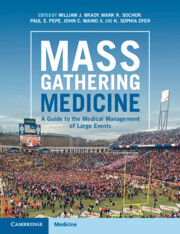Book contents
- Mass Gathering Medicine
- Mass Gathering Medicine
- Copyright page
- Dedication
- Contents
- Contributors
- Foreword
- Preface
- Chapter 1 An Introduction to Mass Gathering Medicine
- Chapter 2 Patient Care at Mass Gathering Events: Basic, Advanced, and Critical Care
- Chapter 3 Prediction of Medical Need and Event Risk Assessment at Mass Gathering Events
- Chapter 4 Medical Logistics and Operational Planning for Patient Care at Mass Gathering Events
- Chapter 5 Medical and Medical Support Staffing at Mass Gathering Events
- Chapter 6 Mass Gathering Medicine: Equipment and Planning Considerations
- Chapter 7 Incident Command System at Mass Gathering Events
- Chapter 8 Security and Other Nonmedical Logistical Support Issues at Mass Gathering Events
- Chapter 9 Understanding Local, State, and Federal Public Safety, Health Care, and Support Agencies
- Chapter 10 Common Themes and General Considerations across Mass Gathering Event Types
- Chapter 11 Mass Gathering Events: Youth, High School, Collegiate, Olympic, and Professional Sporting Events
- Chapter 12 Mass Gathering Events: Music Concerts and Festivals
- Chapter 13 Mass Gathering Events: Motor Sport Events
- Chapter 14 VIP and Executive Medicine Considerations at Mass Gathering Events
- Chapter 15 Mass Gathering Events: Community Events
- Chapter 16 Mass Gathering Events: Endurance Athletic Events
- Chapter 17 Mass Gathering Events: Extended Duration Events
- Chapter 18 At-Risk Populations within Mass Gathering Events
- Chapter 19 Crowd-Related Considerations at Mass Gathering Events: Management, Safety, and Dynamics
- Chapter 20 Civil Unrest and Terrorism Involving Mass Gathering Events
- Chapter 21 Impact of Weather and Climate Change on Mass Gathering Events
- Chapter 22 Occurrence of the Mass Casualty Incident at a Mass Gathering Event
- Chapter 23 Touring Medicine
- Chapter 24 Infectious Disease and Mass Gathering Medicine
- Chapter 25 Toxicology and Mass Gathering Medicine
- Chapter 26 Medicolegal Considerations in Mass Gathering Medicine
- Chapter 27 Business Considerations in Mass Gathering Medicine
- Index
- References
Chapter 25 - Toxicology and Mass Gathering Medicine
Published online by Cambridge University Press: 11 April 2024
- Mass Gathering Medicine
- Mass Gathering Medicine
- Copyright page
- Dedication
- Contents
- Contributors
- Foreword
- Preface
- Chapter 1 An Introduction to Mass Gathering Medicine
- Chapter 2 Patient Care at Mass Gathering Events: Basic, Advanced, and Critical Care
- Chapter 3 Prediction of Medical Need and Event Risk Assessment at Mass Gathering Events
- Chapter 4 Medical Logistics and Operational Planning for Patient Care at Mass Gathering Events
- Chapter 5 Medical and Medical Support Staffing at Mass Gathering Events
- Chapter 6 Mass Gathering Medicine: Equipment and Planning Considerations
- Chapter 7 Incident Command System at Mass Gathering Events
- Chapter 8 Security and Other Nonmedical Logistical Support Issues at Mass Gathering Events
- Chapter 9 Understanding Local, State, and Federal Public Safety, Health Care, and Support Agencies
- Chapter 10 Common Themes and General Considerations across Mass Gathering Event Types
- Chapter 11 Mass Gathering Events: Youth, High School, Collegiate, Olympic, and Professional Sporting Events
- Chapter 12 Mass Gathering Events: Music Concerts and Festivals
- Chapter 13 Mass Gathering Events: Motor Sport Events
- Chapter 14 VIP and Executive Medicine Considerations at Mass Gathering Events
- Chapter 15 Mass Gathering Events: Community Events
- Chapter 16 Mass Gathering Events: Endurance Athletic Events
- Chapter 17 Mass Gathering Events: Extended Duration Events
- Chapter 18 At-Risk Populations within Mass Gathering Events
- Chapter 19 Crowd-Related Considerations at Mass Gathering Events: Management, Safety, and Dynamics
- Chapter 20 Civil Unrest and Terrorism Involving Mass Gathering Events
- Chapter 21 Impact of Weather and Climate Change on Mass Gathering Events
- Chapter 22 Occurrence of the Mass Casualty Incident at a Mass Gathering Event
- Chapter 23 Touring Medicine
- Chapter 24 Infectious Disease and Mass Gathering Medicine
- Chapter 25 Toxicology and Mass Gathering Medicine
- Chapter 26 Medicolegal Considerations in Mass Gathering Medicine
- Chapter 27 Business Considerations in Mass Gathering Medicine
- Index
- References
Summary
Toxicology is the field of science that examines the effects of chemicals, substances, or situations on people, animals, and the environment. A mass gathering is the congregation of a large group of people, usually involving more than 1000 individuals. Mass gatherings can be for any purpose, but are often related to religious, political, and sporting events. Toxicological concerns in mass gatherings include exposures such as toxic gases, contaminated food and beverage supplies, ethanol use, or recreational drug use. The most common concerns are related to ethanol and cannabis use. Providers at mass gatherings should be prepared for a wide range of toxicological challenges. A general understanding of basic toxidromes can further aid in management. Toxidromes can be considered broadly as stimulants/hallucinogens or central nervous system depressants. Management of the undifferentiated intoxicated patient should primarily emphasize support of airway, breathing, and circulation. Providers must also be aware that polysubstance use is common and individuals may present with effects and unpredictable clinical courses. Awareness of toxicological concerns that will present at a specific mass gathering can mitigate risk. Providers should be ready and to adapt to changes and unexpected outcomes.
- Type
- Chapter
- Information
- Mass Gathering MedicineA Guide to the Medical Management of Large Events, pp. 380 - 387Publisher: Cambridge University PressPrint publication year: 2024

